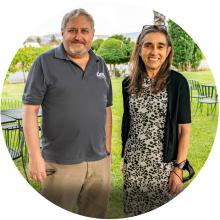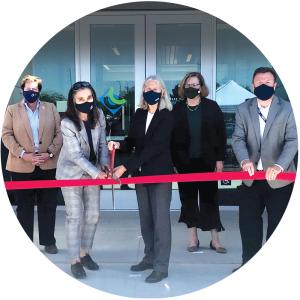Positioning the Laboratory for continuing science and technology excellence directed at important national missions
FY 2021 was a year of building for future mission successes through new initiatives, attention to workforce needs, and expanding partnerships.
Strategic Leadership
On March 2, 2021, Kimberly Budil became the 13th director of Lawrence Livermore National Laboratory and president of Lawrence Livermore National Security, LLC (LLNS). She brought to her new role proven scientific leadership and senior management experience across a broad range of Laboratory programs. During her career, Budil also undertook detailee assignments at NNSA and the DOE Office of Science and served as vice president for national laboratories in the University of California Office of the President. As LLNL Principal Associate Director for Weapons and Complex Integration, Budil recently led the development of a strategic framework for the weapons program that emphasizes attracting the best scientists and engineers and driving the creation of a more responsive and cost-effective nuclear weapons enterprise. Director Budil has launched transformative new initiatives, including actions to articulate a set of future mission focus areas; improve communications; implement a culture framework with attention to diversity, equity, and inclusion; and create a hybrid workplace as the new normal for LLNL operations (see Safe, Secure, and Sustainable Operations).
Director Budil was selected after a rigorous national search that began in July 2020, when William Goldstein announced that he would step down as director upon selection of a successor. Goldstein had led the Laboratory for seven years—a period of myriad challenges, many science and technology innovations, and strong program growth. His exceptional leadership of the Laboratory and service to the nation were recognized with distinguished honors from NNSA and DOE (see Workforce Recognition).
A Changing Workforce
An outstanding workforce is Livermore’s principal strength. Recruiting, training, and retaining exceptional talent is a top priority at LLNL to sustain excellence at a time of rapid change in our workforce. Despite the ongoing pandemic, FY 2021 marked another year of successful hiring across the Laboratory. After COVID-19 struck, LLNL quickly developed the new virtual Onboarding Portal to expedite hiring. The portal significantly streamlines administrative steps and provides an interactive and engaging interface for incoming employees. New hires have a convenient resource to answer their questions, furnish important information about starting work, and participate in new employee orientation sessions that help launch their careers at LLNL.
LLNL’s senior management team is using virtual townhall meetings and workshops to enhance communication within the Laboratory. For example, the “Our Culture” framework adopted by the team was featured in workshops that engaged more than 3,000 employees and served to emphasize the importance of promoting a more respectful work environment with attention to diversity, equity, and inclusion. Management attention to engaging all employees—and emphasizing shared success—contributed to LLNL ranking on Glassdoor’s 2021 list of the top 25 “Best Places to Work” in the U.S. large company category.
New Facilities at the Open Campus
DOE Under Secretary for Nuclear Security and NNSA Administrator Jill Hruby, Congressional representatives, and local elected officials gathered at the Livermore Valley Open Campus (LVOC) in August 2021 for a ribbon-cutting ceremony. The new office building and conference annex (Buildings 642 and 643) are providing modern office and meeting space for LLNL researchers and external collaborators. Residents include the Laboratory’s Innovation and Partnerships Office and the High Performance Computing Innovation Center as well as researchers in predictive biology and materials and manufacturing. The interconnected buildings are the latest additions to the 110-acre LVOC, a joint initiative of the NNSA, LLNL, and Sandia National Laboratories. LVOC was developed as an open and unclassified innovation hub for stimulating collaborative projects with external partners in government, industry, and academia. LVOC provides a unique opportunity for innovators and U.S. companies to leverage the talent and resources within the two laboratories.
At nearly 25,000 square feet, Building 642 contains 105 offices, two double-size “hotel” offices, two conference rooms, and collaboration spaces. The adjacent 2,975-square-foot conference annex can accommodate about 90 people. The facilities, both LEED Gold certified for energy and resource efficiency, are connected by an open, outdoor collaborative environment for meetings and group gatherings.
LLNS Board of Governors Activities
The LLNS Board of Governors and its committees provide oversight to the Laboratory and delve into issues crucial to mission and mission-support activities. External review committees (ERCs), panels of independent experts including Board members, periodically met in FY 2021 to critically assess the quality of the Laboratory’s technical workforce and the effectiveness of research efforts in meeting mission goals and future national needs. Their reports, which provided DOE/NNSA with an independent validation of work quality, consistently affirmed the mission relevance and high impact of LLNL research. The Board chartered functional management reviews (FMRs) on an as-needed basis. Five virtual FMRs, were completed in FY 2021 in topical areas including the Disposition Program and Endpoint Management, the Virtual Desktop Infrastructure, and the Transition to Digital Infrastructure Capability Expansion Project. Recommendations provided by Board committees, ERCs, and FMRs have led to substantive responsive actions.
The DOE Secretary's Virtual Visit
U.S. Secretary of Energy Jennifer M. Granholm virtually visited the Laboratory on June 25, 2021, where she met with leading scientists and engineers. After an all-hands meeting with LLNL employees, she toured the Advanced Manufacturing Laboratory (with the discussion of metal printing shown above), the Livermore Computing Complex, and the National Ignition Facility. Secretary Granholm also heard presentations about climate change, carbon neutrality, and electric grid security.








